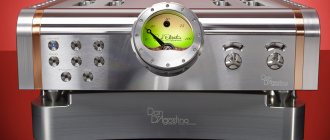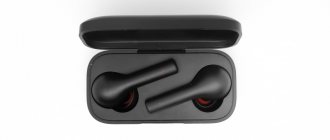Network DAC AURALiC VEGA G2.1
AURALiC introduces an update to the entire award-winning G2 and GX product line with the new G2.1/GX.1 series. Currently, the G2 series is one of AURALiC's most successful projects. Analyzing this success gave the AURALiC team an understanding of what true audiophiles value: above all, audio fidelity, industrial design and a variety of functions. The success of the G2 products was welcome and expected, but the AURALiC team, true to the spirit of innovation, decided that it was time for improvements: in the field of hardware and software. Specifications:
| Design: | DAC with network player function |
| Sampling rates: | PCM: 44.1KHz - 384KHz / 32Bit DSD: DSD64 - DSD512 |
| Frequency range: | 20 Hz - 20 kHz, +/- 0.1 dB |
| Analog audio input: | 1 x RCA (2 Vrms max HT bypass) |
| Analog audio output: | 1 x RCA, 1 x XLR, 2 x Headphone jack 6.3 mm |
| Dynamic Range: | 130 dB |
| Output voltage: | XLR - 4.8 Vrms RCA - 4.8 Vrms |
| Output impedance: | XLR - 5 Ohm RCA - 50 Ohm Headphone - 5 Ohm |
| Digital input: | AES/EBU, Coaxial, Toslink, USB to computer, RJ45 Gigabit Ethernet, AURALiC Lightning Link, Master clock in |
| Supported formats: | Lossless: AIFF, ALAC, APE, DIFF, DSF, FLAC, OGG, WAV, WV Lossy: AAC, MP3, MQA, WMA |
| Supported services: | uPnP/DLNA Media Server, native TIDAL and Qobuz Sublime+ streaming, Spotify Connect, Internet Radio, RoonReady |
| Management programs: | AURALiC Lightning DS for iOS AURALiC Lightning DS for web browser (device setup only) OpenHome compatible control software (BubbleUPnP, Kazoo) Roon (Roon Core required separately) |
| Power consumption: | 50 W maximum 10 W standby |
| Weight, kg: | 9.5 |
| Dimensions, mm: | 340 x 320 x 80 |
| Finish: | Anodized aluminum (matte black) |
Options: Copper shielded housing, improved supports. The G2.1 series components are fully compatible with the G2 series.
Unity Chassis II The G2.1 Series chassis now features a dual chassis-within-a-chassis design, with an outer chassis made of high-grade aluminum and a secondary inner chassis made of copper. These changes improve EMI shielding, delivering noticeable performance improvements. The new metal base, which provides a secure foundation for the G2.1/GX.1 series components, is mounted on improved supports. This gives the devices a modest elegance and has a positive effect on the sound overall. Enhanced Suspension System The balanced weight distribution design found in the original G2/GX Series layout remains unchanged, but a newly developed suspension system further isolates components from external mechanical vibration. Potentially harmful vibrations are dampened by six springs at the core of each mount. Each spring is set to a different tension, allowing vibration damping at different frequencies. This results in greater sound clarity and a more open sound field, and ultimately has a positive effect on the overall sound of the product. CD Playback and Ripping - Latest News from Lightning Streaming AURALiC couldn't ignore the importance of the additional features offered by the tried and tested Lightning OS, which is now in its seventh iteration. At the request of users of AURALiC products, Lighting OS 7.0 will provide CD playback with additional copying capabilities. To do this, simply use an external CD drive connected via USB to a compatible AURALiC product. CD Lightning will read each sector of the disc multiple times to ensure maximum data accuracy, then store it in cache before playback. This minimizes jitter during CD playback, delivering sound levels comparable to high-end dedicated CD players. Lightning Link, continuity One aspect of the overall G2.1/GX.1 design that remains unchanged is the AURALiC Lightning Link protocol, which makes connections between G2/GX and G2.1/GX.1 devices compatible, i.e. devices of the G2 generation and the new generation G2.1 can be connected together and work correctly in one system.
AURALiC network components: Aries G1 and Vega G1
Network audio technology has entered a period of maturity. This is manifested in the abundance of equipment of all price categories, and in the expansion of streaming services, and in overcoming the main problem - user interaction. Not with ordinary music consumers with minimal demands (there are no problems with them), but with advanced, sophisticated and very demanding ones. It is precisely this audience that the AURALiC brand is targeting, two of whose products we will now get acquainted with.
A good part of the difficulties that arise with network technology is due to the fact that it involves a completely different dramaturgy of use than devices for reproducing material media. For example, the script for playing a CD consists of several simple steps: take the CD out of the case, open the loader tray, put the disc on it and press the PLAY button. And that’s it, the music plays, you can start dancing.
It’s no more difficult to add a CD player to your system: take it out of the box, plug in the power cord and connect it to the amplifier with a pair of interconnect cables. The child can handle it.
Versatility, scalability and flexibility make these systems incredibly versatile.
But with a streamer, everything is much more complicated, not only for beginners, but even for those who have been doing this for many years. And not at all because it is necessary to deal with a large number of cords. And not because the network player requires external infrastructure (local network, preferably with Internet access, network storage devices, etc.), but due to the wealth of possibilities and use cases. This is the very case when dignity risks becoming a disadvantage.
But the versatility, scalability and flexibility make these systems incredibly versatile - they can satisfy almost any whim of the owners. As far as music is concerned, of course.
The only thing that is required from the user is to understand his needs and desires. To then convey them to the installer or implement them yourself - if your qualifications allow.
My own playwright
The specificity of modern network devices is largely explained by their genesis - their long-standing ancestor was hotel and ship entertainment content distribution systems, which made it possible to purchase one legal copy (or license) and broadcast it to many listening areas. The idea of multiroom, which manufacturers have been so diligently and long introducing to the masses, originates from there.
Streamers are actually not about multiroom at all. It's about convenience, comfort and high quality playback.
However, it is not at all necessary to arrange several zones based on network components. You can get by with one, well, or two. Even if you live in a studio apartment where the living room, bedroom and kitchen are located in a common space, network audio makes a lot of sense. Streamers are actually not about multiroom at all. It's about convenience, comfort and high quality playback - potentially, of course. To implement it, you need high-class technology - that’s exactly what AURALiC does. Moreover, the very principle of forming the company’s model ranges is designed to stage a wide variety of “plays”. We will consider only a small part of them - only those that can be implemented on the basis of two components - Aries G1 and Vega G1.
SOLO PERFORMANCE ONE: benefit performance of Aries G1
The scriptwriter and main spectator, or rather the listener of this production, is an experienced audiophile; he already has a serious DAC that completely suits its owner in terms of functionality and sound. All you need is network transport - I must say, a very rare type of equipment these days. However, any digital transports, even disk ones, are exotic.
I think this is due to the old stereotype that the digital part of the path is of minimal importance for sound quality. Like, a number is just zeros and ones, what can be spoiled? I will not engage in enlightenment here and try to convince those who, despite all efforts, continue to adhere to this myth. Misconceptions are generally very stable and do not need proof or explanation; they themselves penetrate the mass consciousness, like a virus.
The Aries G1 is a device for those who understand the importance of an accurate and jitter-free digital path.
So, the Aries G1 is a device for those who understand how important an accurate and jitter-free digital path is. Yes, some success can be achieved if you use a specially assembled and configured computer as a transport. In this case, significant costs cannot be avoided (not only money, but also time), and the result is not guaranteed. But to move forward, you need digital transport, specially tailored for high-quality sound reproduction. The first step of this upward movement is Aries G1, the next is Aries G2, but we still need to get there. However, the network basis of the Aries G1 and G2 is common; this is the proprietary Tesla G2 hardware platform - it ensures the responsiveness of the interface, the accuracy of information transfer, and minimal jitter.
When it comes to streaming, the Aries G1 provides absolutely all the capabilities that a modern audiophile, versed in the latest technologies, may require. All types of network connections are provided: Gigabit Ethernet, Tri-Band Wi-Fi 802.11 ac/b/g/n, Bluetooth (for playing music from smartphones). The main streaming services that can provide high quality sound are supported (TIDAL and Qobuz Sublime+, etc.), AirPlay technology, and finally, the device is certified as Roon Ready.
One actor - many roles
On a network, the Aries G1 can play the role of not only a playback device (i.e. player) and renderer, but also a network source - it has a built-in Lightning DS server that is capable of streaming files from external USB drives and from its own internal storage. This opportunity will be very useful if, at the time of purchasing the vehicle, the network infrastructure has not yet been created. By this definition I mean not just a local network (cable or wireless - it doesn’t matter), but also content storage on a NAS. Most network players without such an infrastructure have extremely limited functionality, and some are completely useless.
The Aries G1 can do without it: to start listening to music on it, all you need is a USB drive (flash drive or HDD with music files), a tablet or smartphone with the Lightning DS mobile application. Unfortunately, it is currently only available for iOS, and without it you cannot initialize the library, although you can play files from a USB drive. But it’s easy to do without a wireless router - the Aries G1 itself can organize an access point for the control device.
The developers paid special attention to caching audio data - a separate memory of 1 GB was allocated for buffering.
However, the simplest and, to my taste, correct option for using transport is as a network renderer, that is, a receiving device to which network flows are directed using a control device. And in this case, we can already use Android devices with a variety of third-party mobile applications. This can be Bubble UPnP, Bubble DS, LINN Kazoo, Lumin, and also Roon (provided that there is a machine with Roon Core on the local network). Personally, I found the last option the most convenient.
If the Aries G1 works as a player, reading information from its own storage, from USB drives or network servers, for control you can use not only the buttons on the front panel, but also any remote control - the transport is configured to its commands using proprietary Smart-IR technology . Can you imagine? It is not the remote control that is programmed, but the device itself. I've never seen anything like it before.
Concentration, cleanliness, punctuality
Some readers who have reached this publication probably have a question: what provides the qualitative advantages of the Aries G1 over a conventional computer? After all, in fact, transport is also a computer - why is it better?
First of all, because it is specialized and does not perform extraneous tasks in the background, which we often are not even aware of. For example, it does not collect Big Data. The fact that the audio signal path is optimized specifically for sound reproduction. And also because it uses certain components, for example, femtosecond master oscillators. That is, all necessary measures have been taken to eliminate jitter. Clean power supply for all subsystems important for sound is organized, two separate blocks with their own transformers - one for the display, central processor and DSP, that is, for the computing part of the device, the second for the audio path, including interfaces. Finally, the developers paid special attention to caching audio data: a separate memory of 1 GB was allocated for buffering.
How does all this manifest itself to the ear?
Playing music over the Internet is more pleasant than breathing dust while sorting through your CD collection.
Imagine a city, summer, heat, hot asphalt. If you shoot this on video with a telephoto lens, you will see how hot air rises up and mixes with colder air, bizarrely distorting the view. And the same landscape - on a quiet, cool morning, when the air is absolutely transparent and clean. The first sound picture is a computer, the second is an Aries G1. Well, or you can compare the sound of a live ensemble in the studio and the same sound recorded on magnetic tape.
Towards the end of this “staging”, I will note that the transport has not only traditional digital outputs (optical, coaxial, AES/EBU), but also asynchronous USB - through it you can transmit DSD streams to the DAC. And this is, in my opinion, the best interface for connecting the Vega G1.
SOLO PERFORMANCE TWO: benefit performance Vega G1
The potential author of the play is a quality-conscious music lover who realized that playing music over the Internet is more pleasant than breathing dust while sorting through a collection of CDs. And at the same time I decided to get a decent DAC. Essentially, this is a story about killing two birds with one stone.
Vega G1 is also a streamer, although with lighter network functionality compared to Aries G1, but with a serious built-in digital-to-analog converter. You can say this: this is a streaming DAC.
Vega G1 is also a streamer, although with lighter network functionality compared to Aries G1.
The network platform, unlike the Aries G1, is the previous generation - Tesla G1 and there are no wireless interfaces (only Ethernet), as well as a built-in server and a USB A connector for external drives. Accordingly, on the network it can only play the role of a renderer, that is, a device that reproduces streams directed to it by the controller - all the same devices running iOS devices with the Lightning DS application or Android smartphones and tablets with Bubble UPnP, Bubble DS, LINN Kazoo, Lumin and Roon. But if for the Aries G1 the presence of Lightning DS is almost mandatory, then for the Vega G1 it is optional - it does not have functions that cannot be used from Android.
There is also Smart-IR, which makes it possible to program the device to be controlled by any remote control. There is a web interface through which you can adjust almost all the DAC settings - a very useful thing if the Vega G1 is part of a multiroom system and installed in another room. By the way, to my taste, working with the web interface is more comfortable than working with the screen of the device itself. By the way, the Aries G1 also has a web control interface, Naturally, with different settings.
Secrets of creative cuisine
AURALiC does not provide detailed information about the design of its equipment. All that is known about the design of the DAC is that it is built on a chip from ESS Technology, but customized. Since the switchable digital filter has only four presets (Precise, Dynamic, Balance, Smooth), let me assume that the basis for the modified chip was the ES9018 Pro. The output stages are based on ORFEO amplifier modules operating in class A. What is inside them is not reported. Analogue outputs, as befits a serious device, are balanced and normal.
It is known that the object of special attention of the developers was the elimination of jitter, therefore the DAC uses exclusively precision femtosecond clock generators. The USB interface is galvanically isolated, which prevents interference from the computer if it is used as a digital source. Built on the XMOS platform - this is also not reported, but you can guess from the drivers for Windows. Let me note in passing that the final quality of the USB interface depends to the greatest extent not on the chip itself, but on its wiring, on the quality of the wiring, components and power supply. So, AURALiC has done all this at the highest level, which can be seen both in the clear operation of the interface and in the sound.
Pleasure for two
The output of the Vega G1 can be adjustable or fixed - switched in the settings menu. Accordingly, the round knob on the right serves not only to navigate the graphical interface, but also to adjust the volume, which allows you to connect the device directly to a power amplifier. If there are no other analog sources in the system, then the pre is not needed.
The two 6.3 mm jacks on the left are headphone outputs; they are connected in parallel and are not switched. So you can listen to music together. There is no word on the design of the headphone amplifier. But he plays very well. At the same time, he doesn’t care at all what the impedance of the headphones is - whether it’s 300 ohms or 16 ohms - the sound depends solely on the quality of the headphones themselves. Well, from a digital source too.
The presence of a headphone amplifier allows you to use the Vega G1 to sound a separate small area, say, in the bedroom. True, he will need an Ethernet cable, because he does not have a wireless interface.
Even lying a little so that some recordings sound more beautiful” - the DAC is not suitable for this. Accuracy and impartiality are his credo.
Since we have a one-man show, a local network and a computer transport with the Roon client installed on it were used as a digital source, which simultaneously served as the Core - without a “core” the mobile application does not work.
It is very difficult to notice by ear which connection is involved, network or via USB from a computer - the DAC plays wonderfully in both cases. Apparently, competently implemented buffering and resynchronization of received streams has an effect.
The specific character of ESS chips, which manifests itself in meticulous attention to the top of the range and the desire to pull out the smallest details, is practically not evident here. But you can hear that this is not an AKM chip. The sound is completely neutral, precisely balanced, but not boring. The emotional essence of the music is conveyed well, but even lying slightly to make some recordings sound “beautiful” is not an option for the DAC. Accuracy and impartiality are his credo.
PERFORMANCE THREE: Duet of “stars”
In a real theater, this is a more expensive format than a one-man show, but it is easier for the performers - they do not have to hold the attention of the audience alone throughout the entire production. With us it’s a little different, because the “actors” act in full contact (which doesn’t always happen on the theater stage) and as a single whole.
Yes, the Aries G1 and Vega G1 overlap in network functionality, but only partially. In any case, the duplication of functions is not so great as to refuse to combine two devices in one system.
The connection is via USB, since, as already mentioned, this is the only way we can transfer DSD streams in Native format from the transport to the DAC without intermediate conversion to PCM. No drivers are required. Album art is only shown on the Aries G1's display in this option, while the Vega G1's display shows the input signal parameters and output level.
I just listened to these devices separately, they showed themselves to be extremely worthy, but I did not expect that combining them would give such a powerful synergistic effect.
Resolution has increased noticeably, and delicate details have emerged, especially at the edges of the range, which were previously unheard of. At the same time, there was no tedious sharpness or excessive brightness, no recording defects appeared - the sound picture simply became even more transparent and distinct. More reliable. The voices came to life. Listening is not just more pleasant - it is easier, because the brain is constantly processing, compensating for missing or incorrect information. And here our inner personal DSP can relax...
After all, only we, specialists and experts, need audio equipment for work (like theater for critics and theater experts), and all normal music lovers need it for pleasure. AURALiC equipment can, as it turns out, not even the most expensive models.
AURALiC Aries G1
Manufacturer: AURALiC (USA/China)
https://t-art.ru/k2/auralic
Functions: digital player, network renderer, player, server || Playable formats: AIFF, ALAC, APE, DIFF, DSF, FLAC, OGG, WAV, WV, AAC, MP3, MQA, WMA || Maximum stream parameters: PCM: up to 384 kHz/32 bits, DSD: up to DSD512 (22.57892 MHz) || Control: AURALiC Lightning DS applications for iOS and web, compatible with OpenHome (Bubble UPnP, Kazoo), Roon, IR || Sources: network folders, USB storage, UPnP/DLNA server, built-in TIDAL and Qobuz Sublime+ applications, Internet radio, Roon Ready, AirPlay, Bluetooth, Songcast || Outputs: AES/EBU (balanced), RCA (coaxial), Toslink (optical), USB (to compatible DAC) || Network: Gigabit Ethernet, Wi-Fi Tri-Band 802.11 ac/b/g/n || Power Consumption: <50W, Standby <10W || Dimensions (W x D x H): 340 x 320 x 80 mm || Weight: 7.2 kg || Price: 182,400 rub.
AURALiC Vega G1
Functions: DAC, network renderer, player || Maximum stream parameters: PCM: up to 384 kHz/32 bits, DSD: up to DSD512 (22.57892 MHz) || Frequency range (+/- 0.1 dB): 20 Hz - 20 kHz || Outputs: analog asymmetrical (2 x RCA), balanced (2 x XLR), headphones (2 x 6.3 mm) || Dynamic range, dB: 127 || Line Output Voltage (RMS): 4.8 V || Digital Interfaces: AES/EBU, Coaxial, Toslink, USB, RJ45 Gigabit Ethernet || Supported formats: AIFF, ALAC, APE, DIFF, DSF, FLAC, OGG, WAV, WV, AAC, MP3, MQA, WMA || Network services: UPnP/DLNA Media Server, native TIDAL and Qobuz Sublime+, Spotify Connect, Internet Radio, RoonReady || Control: AURALiC Lightning DS applications for iOS and web, compatible with OpenHome (Bubble UPnP, Kazoo), Roon, IR || Power Consumption: <50W, Standby <10W || Dimensions (W x D x H): 340 x 320 x 80 mm || Weight: 7.0 kg || Price: 349,600 rub.
share
Tags: AURALiCAURALiC Aries G1AURALiC Vega G1











